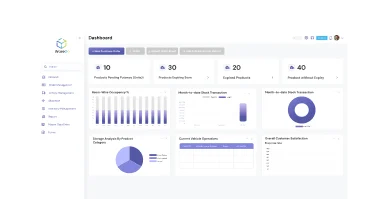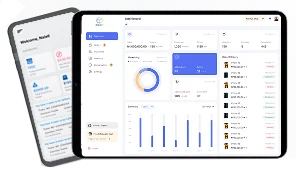
In this competitive market, where data and fast-paced operations have become crucial than ever before, a well-built ecommerce wms is what will save you from drowning.
Regardless of the circumstances, running a business — whether it’s big or small, online or in-store — ecommerce management will always remain a complex endeavor.
In-store retailers require ecommerce integrations for vendors, whereas online retailers must organize and oversee everything through different ecommerce warehouse management system for a better vision.
In any case, tracking is necessary to create a path of recording and analyzing your products, and it’s a vital process to oversee all components of an online store.
As an online owner, what should be the goal?
The most basic and essential goal for your business as an owner is customer retention and making them happy at any cost. And e-commerce marketing is the best way to do it, as they love it.
According to research by Statista, e-commerce sales are projected to increase by $7.9 billion in 2025, helping e-commerce owners make their businesses more effective.
In this article, we will explore e-commerce management, its challenges, and strategies for addressing them to achieve your business objectives.
It's time to grow your ecommerce business with the help of WareGo.
Get started now!Table of Contents
Ecommerce Management and Its Importance
Before digging directly into e-commerce management systems and their challenges, it’s essential to understand what e-commerce management is and why it’s crucial for running a business.
E-commerce management is the practice of maintaining and optimizing an online business to achieve the goal you set at the very start.
Maintaining an ecommerce strategy will enable you to focus on product quality and customer retention, while delivering all customers their desired goods and providing a brand-aligned good customer experience.
Ecommerce managers who work closely with their teams to develop strategies, such as enhancing the buyer journey, improving customer retention, implementing affiliate programs, and optimizing the overall digital experience, can make a significant impact on their business.
In addition to everything else, incorporating ecommerce management as a crucial element in your ecommerce operations.
However, avoid inventory challenges, such as over- and underselling, which can adapt to demand fluctuations in real-time. This will help them stay competitive and remain in the market’s attention.
E-commerce warehouse management support services that also magnify the ability to show support to both customers and the business.
Challenges of Ecommerce Management & Its Solutions
A cornerstone does not always remain on top. There are always some challenges that need to be solved.
Just like that, ecommerce management also faces some challenges, and if not addressed promptly, can lead to greater losses than anticipated.
Here are five common challenges that an ecommerce manager can face in the digital ecommerce management world. Also, let’s see if the solutions get along together!
1. Supply Chain Disturbances
The last few years have presented significant challenges for ecommerce businesses, as they have had to contend with substantial disruptions to their supply chains.
Global shipping delays and rising logistics supply chain costs have widely impacted delivery timelines and revenue.
Solution
To minimize these inefficiencies, you can:
- Maintain direct contact with manufacturing partners.
- Bring diverse strategies to optimize their sourcing.
- Collaborate with freight forwarders or alternative partners for a smooth flow.
- Sell through what is available, and focus on working capital management.
2. No Attention to Marketing Strategies
When running an ecommerce management service, a competitive marketing strategy is a key way to move forward. You will need a sharp mind to develop an effective marketing strategy that captures your clients’ attention.
Drive traffic by converting your viewers into buyers; for that, an eye-catching marketing plan is essential.
Solution
To grab all eyes, you must:
- Understand market trends and how you can twist them in your business.
- Focus on short-tail keywords for the online website and social media.
- Collect emails or phone numbers to run targeted messaging campaigns.
- Utilize digital marketing methods to capture users’ attention, fostering loyalty and trust.
3. No Accurate Inventory Check
Measuring & tracking inventory is one of the biggest challenges in ecommerce business management. It’s challenging to accurately measure what has been sold and what hasn’t, which can lead to confusion regarding product quantity.
Over- or under-stocking becomes the worst-case scenario here; if you are overstocked, it will be a hurdle for you, and if understocked, it will cause customers to wait. Hence, there will be no way to satisfy them without letting them go to competitors.
Solution
Measures you can take to track inventories:
- Use the right ecommerce tools for tracking.
- Opt for a proper ecommerce wms.
- Synthesize inventories on all sales channels.
- Review slow-moving items in your inventory.
4. Poor Order Management
As your order fulfillment increases day by day, it becomes increasingly complex to manage all at once. Picking, packing, and shipping quickly outpace the capacity, leading to more errors and delays in orders.
Poor order management makes things crucial and adds complexity to managing accurate inventory, which in turn affects customer satisfaction with their orders.
Solution
To prevent delays and errors, try doing:
- Incorporate an order management system (OMS) to handle orders
- Collaborate with 3PL warehouse management software to increase efficiency and accuracy.
- Optimize various carrier networks for orders.
- Focus on the precise picking and packing of orders.
5. Customer Acquisition
Both new and existing customers are crucial to running an ecommerce business. However, attracting new customers can sometimes be a challenge.
Every customer has different requirements, but they consistently demand the product, which makes it harder to cope with in a competitive market.
Solution
To keep customers on board, you must:
- Create a customer base for them.
- Implement campaigns and offer free items to first-time buyers.
- Emails and messaging alerts to make them remember you.
- Follow rule 101: customers are always right.
WareGo is ready to provide you with an all-in solution for everything!
Get a Free Demo!4 Essential Ways for Ecommerce Warehouse Management Success
After we have covered the challenges and how to excel at solving them, it’s time to unlock some secret strategies for success in your ecommerce warehousing.
Here are four main routes that can lead to a successful road if you follow them correctly and steadily.
1. Productive & Smart Warehouse Layout
- Plan your warehouse and then flow into it. Minimize unnecessary staff and goods to reduce the chances of errors.
- Prioritize seasonal items. Referring to those in priority, the products are in high demand or experiencing a seasonal peak.
- Maximize vertical space by installing racking systems to increase storage capacity and maintain organization.
2. Embrace Automation and Technology.
- Install a robust WMS for e-commerce in your business to improve efficiency.
- Focus on seamless ecommerce integrations to expand business options widely. (Shopify, Amazon)
- Use more devices, such as phones, tablets, and printers, to record everything.
- Implement barcodes, RFID, and AS/RS systems to reduce ecommerce wms costs.
3. Streamline Returns
- Develop an efficient process to handle returns and shipments for your products.
- Designate a specific area in your warehouse for returns to prevent disruptions and ensure they are handled efficiently and correctly.
- Update customers with accurate return information and guide them through the complete return process.
- Reduce manual work to minimize errors and ensure customer satisfaction.
4. Prioritize Order Fulfillment
- Focus on selecting methods such as batch picking or multi-order picking to save time.
- Include quality checks at every stage, including receiving, packing, and shipping.
- Automate workflows to avoid double work and prioritize important things first.
- Implement strategies for picking and receiving to save labor costs.
Best Practices of Ecommerce Management
While challenges are being addressed, several key practices should be considered when managing digital commerce.
Let’s unravel some best practices to enhance your e-commerce operations.
| Practice | Purpose | Tools to Use |
| Use mobile optimization | Collects a large amount of traffic. | GTmetrix, BrowserStack. |
| Implement e-commerce platforms. | It integrates payment, shipping, and marketing tools. | Shopify, Amazon. |
| Work with Ecommerce CRM | They make personalized marketing tools. | HubSpot CRM, ActiveCampaign. |
| Opt for ecommerce WMS | Tracks real-time inventory and barcoding. | WareGo, ShipBob. |
| Enhance SEO keywords | Brings organic search ranking. | Google, Ahrefs. |
| High-quality Visuals | Built high-quality images for content. | Chat GPT, Jasper. |
Conclusion: WareGo is the Only Solution for Your Ecommerce Management
E-commerce management is now beyond our thinking. This management requires multi-layered approaches and full-time involvement of technology, strategies, and customer insights.
Hence, WareGo is there to take all your workload off and maintain stable, strategic operations for your e-commerce management services, allowing you to grow in all possible ways.
It’s time for you to invest in the best ecommerce tools, platforms, and integrations to build a thriving e-commerce future for your business, and WareGo can help you with this process.
WareGo is here to guide you through e-commerce management with complete guidelines.
Book a Free Demo Now!Frequently Asked Questions- FAQS
Is hiring an ecommerce manager better than working with an ecommerce management service?
This depends on the specific needs and resources of your business. An e-commerce manager is more determined towards dedicated expertise in deeper integrations with the X Company culture. Working with a management service brings specialized knowledge and scalability to your business.
What are the four types of e-commerce?
The main types of e-commerce are:
- Business-to-consumer (B2B)
- Business-to-business (B2B)
- Consumer-to-consumer (C2C)
- Consumer-to-business (C2B)
What are the 5 C’s of ecommerce?
The five C’s of e-commerce are:
- Company.
- Customers.
- Competitors.
- Collaborations.
- Context.
What is ecommerce management?
E-commerce management is the practice of maintaining and optimizing an online business to achieve the goal you set at the very start. It includes:
- Inventory and processing orders.
- Marketing strategies.
- Customer services.
- Website security.






![Ecommerce WMS Cost Explained [Don’t Overpay in 2025]](https://warego.co/blog/wp-content/uploads/2025/07/Ecommerce-Warehouse-Management-System-Cost-300x136.jpg)
